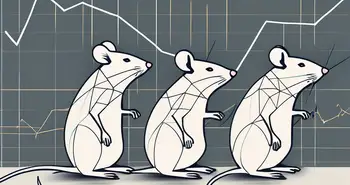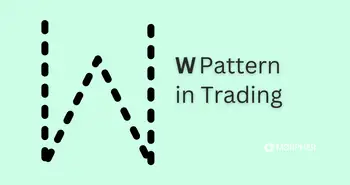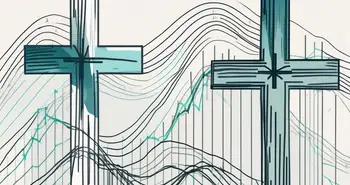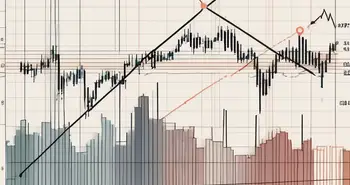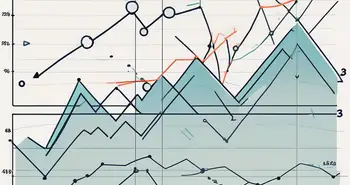Article Contents
Top Picks: The Most Successful, Profitable, and Reliable Chart Patterns
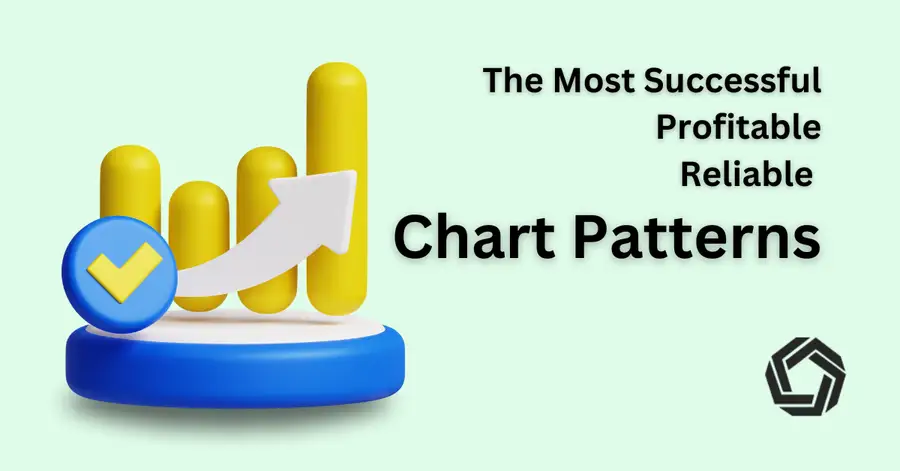
We already covered many essential aspects of technical analysis, from basic price movements to an in-depth look at chart formations in our Updated Candlestick Patterns Guide. But now it’s time to take things up a notch. We’re diving into the A-Team of chart patterns, those select few that have proven themselves to be the most successful, profitable, and reliable across markets. In this article, we’ll skip the theory and get straight to the patterns that traders can really count on. Let’s break down the top picks that should be in every trader’s toolbox.
1. Head and Shoulders Pattern

Why It's Successful: The Head and Shoulders pattern is renowned for its reliability in signaling reversals. It typically forms after a long upward or downward trend, providing an excellent opportunity for traders to enter at the beginning of a new trend. This pattern is particularly effective in stocks, forex, and even volatile markets like crypto. It represents a clear loss of momentum and foreshadows a strong price movement in the opposite direction.
How to Trade It:
- Spot the left shoulder, head, and right shoulder pattern, with a clear neckline connecting the bottoms of the shoulders.
- A breakout below the neckline with high volume is your signal to enter a short position in a bearish reversal.
- For inverse patterns (bullish reversals), wait for a breakout above the neckline.
Stop-loss should be placed just above the right shoulder, while the target can be calculated by measuring the height of the head from the neckline.
Pro Tip: Use this pattern in conjunction with a momentum indicator like the RSI to confirm the exhaustion of the current trend.
2. Double Tops and Double Bottom

Why It's Profitable: These patterns indicate a clear trend reversal, with a failure to break past a certain resistance or support level twice. Traders can profit by catching the new trend early.
How to Trade It:
- For double tops, look for two peaks of similar height and a breakout below the support level.
- For double bottoms, find two troughs and enter after a breakout above the resistance.
- Use a conservative stop-loss just below the second bottom/top.
3. Cup and Handle
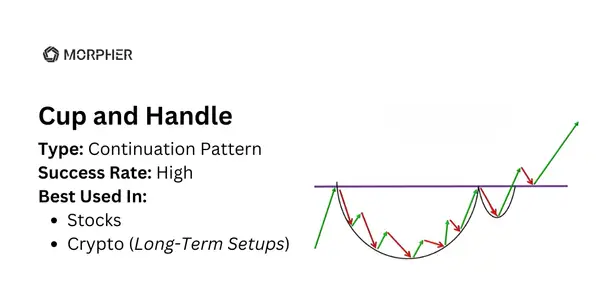
Why It's Reliable: This pattern signals a bullish continuation after a period of consolidation. The “cup” forms during a consolidation period, and the “handle” signals a smaller correction before a breakout.
How to Trade It:
- Enter once the price breaks above the resistance at the top of the handle with high volume.
- Set your stop loss below the handle to protect against a false breakout.
- Target can be set by measuring the depth of the cup and projecting it upward from the breakout point.
4. Ascending/Descending Triangles
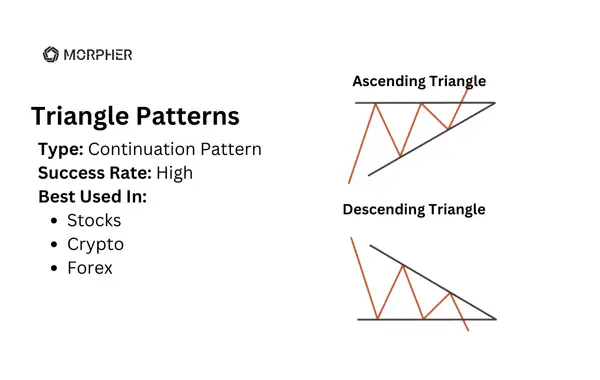
Why It's Profitable: These patterns indicate strong continuation of the current trend. Ascending triangles are bullish, while descending triangles are bearish.
How to Trade It:
- Enter on the breakout of the horizontal resistance (ascending) or support (descending) with high volume.
- Set a stop loss just below/above the triangle’s slanting trendline.
- Profit targets can be set by measuring the height of the triangle and projecting it from the breakout point.
5. Bullish and Bearish Flags
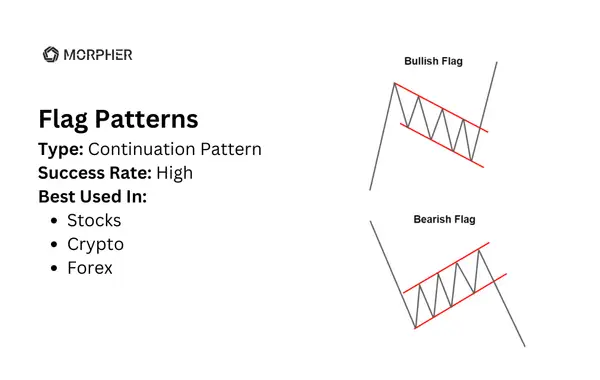 Why It's Profitable: Flags are known for their high accuracy during trends. After a strong price movement, the market consolidates in a flag shape before continuing in the direction of the trend.
Why It's Profitable: Flags are known for their high accuracy during trends. After a strong price movement, the market consolidates in a flag shape before continuing in the direction of the trend.
How to Trade It:
- Enter on a breakout from the flag pattern in the direction of the initial trend.
- Set your stop loss at the low of the flag in bullish flags, or the high in bearish flags.
- Target can be set based on the height of the flagpole, projected from the breakout point.
Tired of second-guessing your trades? Take your strategy to the next level with Morpher AI.
Morpher AI empowers traders with real-time market insights and advanced chart analysis to help you make smarter, faster decisions. Whether you're tracking wedges, triangles, or flags, let AI do the heavy lifting so you can focus on profiting. Explore Morpher AI now and see how it can transform your trades.

6. Wedge Patterns (Rising/Falling Wedges)

Why It's Reliable: Wedge patterns signal a trend reversal. Rising wedges indicate bearish reversals, while falling wedges point to bullish reversals. The tighter the pattern, the more explosive the breakout.
How to Trade It:
- Enter when the price breaks out of the wedge pattern with significant volume.
- Set a stop loss below (for bullish) or above (for bearish) the breakout.
- Profit targets can be determined by measuring the wedge height and projecting it from the breakout point.
7. Triple Tops and Triple Bottoms
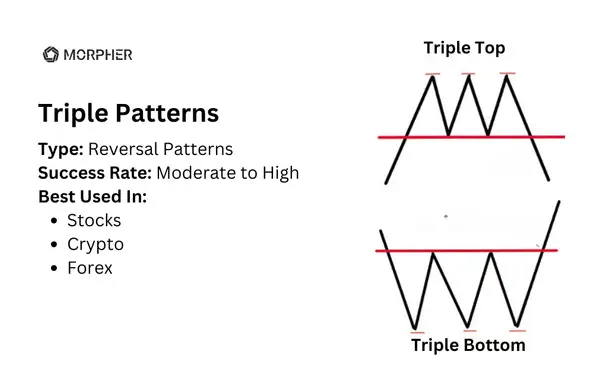
Why It's Reliable: These patterns work like double tops/bottoms but with an additional confirmation of a third failed attempt to break resistance/support. This additional point adds confidence to the reversal.
How to Trade It:
- Trade it similarly to double tops/bottoms but with greater confirmation.
- Enter on the breakout of the neckline, set stop-loss at the recent peak or trough, and target based on the height of the pattern.
8. Symmetrical Triangles
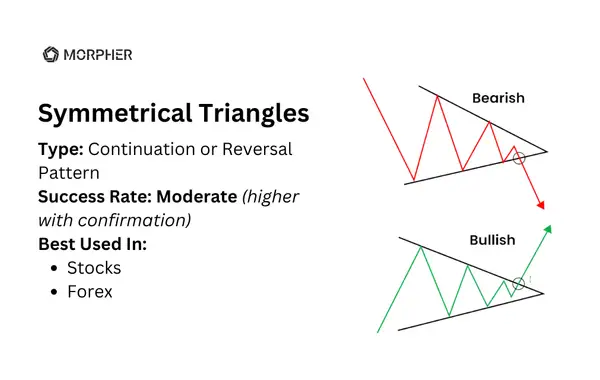
Success Rate: Moderate (higher with confirmation)
Best Used In: Forex, Stocks, Crypto
Why It's Useful: This pattern is often neutral and signals a period of consolidation before a breakout, which could be in either direction. When confirmed with volume, it becomes highly reliable.
How to Trade It:
- Wait for the breakout (either up or down) with high volume for confirmation.
- Set your stop loss on the opposite side of the breakout.
- Profit targets can be calculated by measuring the base of the triangle and projecting it in the breakout direction.
How To Read Chart Patterns
Identifying reliable chart patterns is only the first step. To increase your chances of success, it's crucial to know how to interpret these patterns and use them to inform your trading decisions.
Step-by-Step: Identifying Reliable Patterns
When looking for reliable chart patterns, it's essential to consider the following:
- Confirm the pattern with other technical indicators.
- Look for patterns that have occurred on multiple timeframes.
- Consider the volume accompanying the pattern.
- Pay attention to the overall market context.
Using Chart Patterns to Determine Entry and Exit Points
Once you have identified a reliable chart pattern, it's time to determine your entry and exit points. Many traders use the breakout strategy, entering a trade when the price breaks above a resistance level or below a support level. Others prefer to wait for a retest of the breakout level to ensure its validity.
As an expert trader, I have had my fair share of experiences with chart patterns. One particularly memorable moment was when I identified a Cup and Handle pattern on a stock I had been monitoring for months. Combining my technical analysis skills with a deep understanding of the pattern, I decided to enter a long position just before the anticipated breakout. To my delight, the stock surged, and I ended up booking significant profits in a relatively short period.
Practical Tips for Trading Chart Patterns
- Use Volume for Confirmation: Chart patterns are more reliable when accompanied by high volume during breakouts.
- Combine with Technical Indicators: Success rates improve when combined with RSI, moving averages, or other technical indicators.
- Set Conservative Stop-Losses: Protect against false breakouts by setting stop-losses just beyond key support or resistance levels.
- Backtest Patterns in Your Market: Each market can have unique tendencies, so backtest patterns before using them in live trades.
Frequently Asked Questions
What are the most successful chart patterns in trading?
Some of the most successful chart patterns in trading include the Head and Shoulders pattern, Double Top and Double Bottom patterns, Triangle patterns, the Cup and Handle pattern, and the Flag and Pennant patterns.
How can chart patterns predict market movements?
Chart patterns provide insights into the psychology of market participants and offer clues about the future direction of an asset. By studying historical performance and price action following specific patterns, traders can make educated predictions about future market movements.
What should I consider when identifying reliable chart patterns?
When identifying reliable chart patterns, it's crucial to confirm the pattern with other technical indicators, look for patterns that have occurred on multiple timeframes, consider the volume accompanying the pattern, and pay attention to the overall market context.
How can I use chart patterns to determine entry and exit points?
Many traders use the breakout strategy when using chart patterns to determine entry and exit points. They enter a trade when the price breaks above a resistance level or below a support level. Others prefer to wait for a retest of the breakout level to ensure its validity.
Chart patterns are like the language of the markets, providing valuable insights that can help traders navigate the ever-changing financial landscape. By honing your ability to identify and interpret these patterns, you can unlock a world of trading opportunities. So, arm yourself with knowledge, practice diligently, and let the power of chart patterns guide you towards success in the exciting world of trading.
Ready to put your chart pattern knowledge to the test? Join Morpher, the revolutionary trading platform that leverages blockchain technology to offer zero fees, infinite liquidity, and a unique trading experience. Whether you're interested in stocks, cryptocurrencies, or even niche markets like NFTs, Morpher's fractional investing, short selling capabilities, and up to 10x leverage have you covered. Sign up now at Morpher.com and get your free sign-up bonus to start trading the way you've always wanted to!

Disclaimer: All investments involve risk, and the past performance of a security, industry, sector, market, financial product, trading strategy, or individual’s trading does not guarantee future results or returns. Investors are fully responsible for any investment decisions they make. Such decisions should be based solely on an evaluation of their financial circumstances, investment objectives, risk tolerance, and liquidity needs. This post does not constitute investment advice.

Painless trading for everyone
Hundreds of markets all in one place - Apple, Bitcoin, Gold, Watches, NFTs, Sneakers and so much more.

Painless trading for everyone
Hundreds of markets all in one place - Apple, Bitcoin, Gold, Watches, NFTs, Sneakers and so much more.

